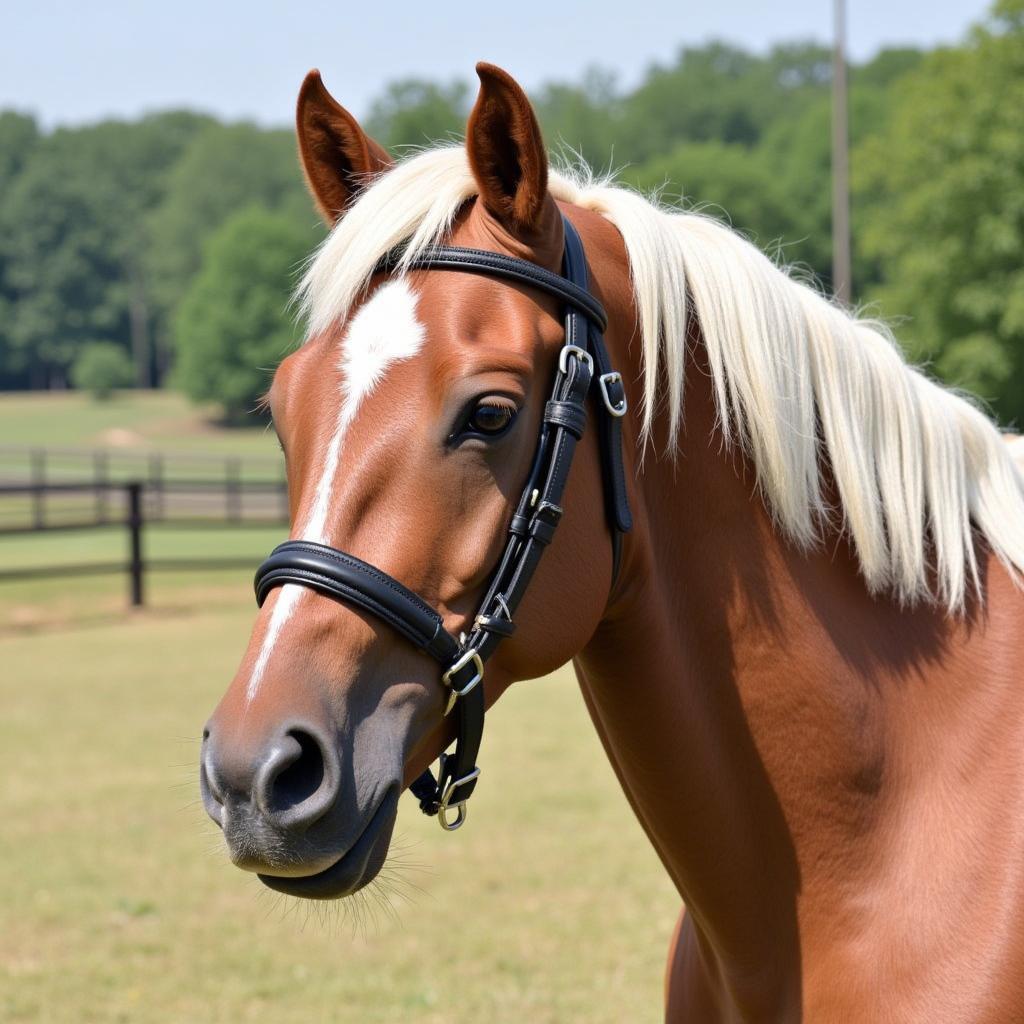The Horse Chin Strap, a seemingly small detail on a horse’s bridle, plays a crucial role in achieving a secure and comfortable fit. Often overlooked, this unassuming strap can significantly impact communication between horse and rider, ensuring a safe and enjoyable experience for both.
The Purpose of a Horse Chin Strap
The primary function of a horse chin strap is to stabilize the bridle, preventing it from slipping over the horse’s ears, especially during sudden movements or when pressure is applied to the reins. This is particularly important for:
- Young or Green Horses: Horses new to wearing a bridle may try to rub it off with their legs or by shaking their heads. A properly adjusted chin strap provides that extra bit of security, helping them acclimate to the bridle.
- Horses with Narrow Heads: Some breeds naturally have more delicate head structures. A chin strap helps keep the bridle in place, preventing discomfort or potential injury from a loose fit.
- Riding Disciplines: Certain disciplines, such as jumping, involve dynamic movements that can shift the bridle. A secure chin strap is essential for maintaining control and clear communication with the horse during these activities.
Choosing the Right Chin Strap
While the basic function remains the same, horse chin straps come in various styles and materials. Consider these factors when selecting the best option for your horse:
- Material: Leather chin straps are popular for their durability, classic look, and ability to soften and conform to the horse’s jaw with use. Synthetic materials like nylon or biothane are lightweight, easy to clean, and often more affordable.
- Width: A wider chin strap distributes pressure over a larger area, enhancing comfort for the horse. However, the ideal width depends on the horse’s size and head shape.
- Padding: Padded chin straps provide additional comfort, especially for horses with sensitive skin or those ridden for extended periods.
- Adjustability: Opt for a chin strap with multiple adjustment holes to achieve a secure yet comfortable fit.
Proper Fit: A Key to Comfort
A correctly fitted horse chin strap is neither too loose nor too tight. Ideally, you should be able to fit two fingers comfortably between the strap and the horse’s jaw. Too loose, and it defeats its purpose of securing the bridle. Too tight, and it can cause discomfort, restrict airflow, and even lead to injury.
Common Signs of an Ill-Fitting Chin Strap
Be attentive to your horse’s behavior as it can indicate a poorly fitted chin strap:
- Head Tossing: A horse may toss its head excessively in an attempt to relieve pressure from a tight strap.
- Gaping Mouth: Constant opening of the mouth can signal discomfort or restricted airflow.
- Rub Marks: Check for any hair loss or skin irritation under the chin strap, which are clear signs of an ill-fitting or overly tight strap.
Beyond Basic Function: Specialized Chin Straps
While the standard chin strap serves a fundamental purpose, specialized options cater to specific needs:
- Crank Nosebands: Often used in disciplines like dressage, these nosebands incorporate a leveraged chin strap to discourage the horse from opening its mouth.
- Drop Nosebands: Designed to discourage the horse from raising its head too high, these nosebands utilize a strategically placed chin strap that tightens when the head is lifted.
 Horse Bridle with Properly Adjusted Chin Strap
Horse Bridle with Properly Adjusted Chin Strap
Conclusion: Choosing Comfort and Control
A horse chin strap might seem like a small detail, but its importance for both horse and rider comfort and safety shouldn’t be underestimated. By understanding its purpose, selecting the right type, ensuring a proper fit, and recognizing signs of discomfort, you can ensure a more harmonious and enjoyable riding experience. Remember, even the smallest details can make a big difference when it comes to the well-being of our equine partners.
FAQs About Horse Chin Straps
1. Do all horses need a chin strap?
While not strictly mandatory for every horse, a chin strap is generally recommended for most riding situations to ensure bridle stability and rider safety.
2. Can I adjust the chin strap myself?
Yes, most chin straps have multiple adjustment holes. It’s crucial to learn how to properly adjust it for a secure and comfortable fit.
3. What should I do if my horse seems uncomfortable with the chin strap?
Immediately loosen the strap and check for any signs of rubbing or irritation. If discomfort persists, consult with a qualified equestrian professional.
4. Are there alternatives to traditional chin straps?
Some bridles utilize alternative designs that eliminate the need for a separate chin strap. However, it’s essential to ensure these designs provide adequate stability and comfort.
5. How often should I check the fit of my horse’s chin strap?
It’s good practice to check the fit before each ride, especially if the bridle or chin strap is new.
Looking for the perfect bridle and accessories? Check out our range of horse bridles and bits. We offer a variety of high-quality options to suit your needs. You might also be interested in our selection of horse saddles and accessories for the complete riding experience.
Remember, if you need any assistance selecting the right equipment for your horse, please contact us. At Justus Horses USA, we’re here to help you choose the best options for your equine partner’s comfort and well-being. You can reach our team at 0772127271, or email us at [email protected]. We’re available 24/7 to answer your questions. We’re also located at QGM2+WX2, Vị Trung, Vị Thuỷ, Hậu Giang, Việt Nam, and would love for you to visit us!